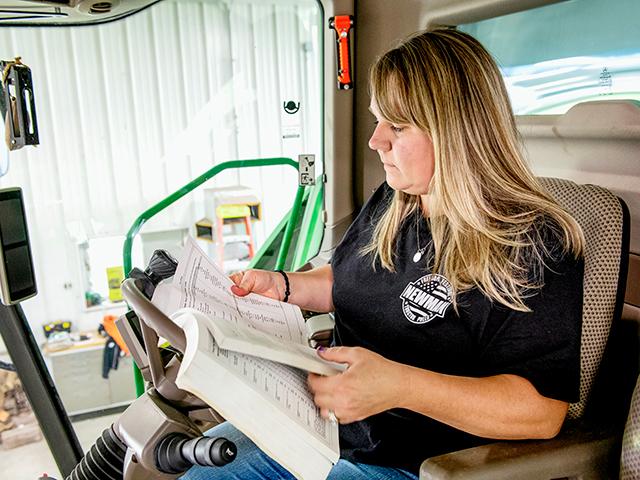DTN Fieldwork Roundup
As Corn Harvest Kicks Off, Farmers Scout Fields and Worry About Trade
ROCKVILLE, Md. (DTN) -- As combines slowly start rolling in parts of the Corn Belt, many farmers are expecting a big crop -- and some are worried about where it might go.
"All my worries revolve around trade right now," said northwest Iowa farmer Jay Magnussen, who -- with harvest looming and cattle to tend -- has plenty to worry about.
"It's essential that we get deals made with our trading partners and get things exported," he said.
Magnussen's concerns were echoed by many of the DTN Agronomy Advisers, a group of farmers and ranchers whom DTN periodically surveys on fieldwork, crop conditions and other issues facing agriculture.
This week, they reported back on the usual late-summer fare -- scouting fields, checking corn moisture and starting harvest -- but also voiced concerns about commodity prices depressed by the trade war and weighed in on USDA's trade aid package.
HARVEST INCHES FORWARD
Oklahoma farmer Zack Rendel is deep enough into corn harvest to already have a headache: Aflatoxin has surfaced in some of his cornfields and his neighbors'. See the DTN story here: https://www.dtnpf.com/….
To add to that blow, his corn yields are coming in a solid 10- to 20-bushels per acre lower than he hoped. "We pollinated fine, but we got really hot and droughty at grainfill time," he explained. "That dropped our kernel size down and we tipped back a lot -- that's what's bringing yield down."
In better-watered fields of Illinois and Indiana, the early corn picking has been less disappointing.
Two Illinois farmers, John Werries and Josh Miller, kicked off corn harvest on Aug. 27. That's a record-early start for Miller, who farms in the southern tip of the state and recently added a grain dryer to his operation.
P[L1] D[0x0] M[300x250] OOP[F] ADUNIT[] T[]
"[Corn] is running from 24% to 30%," he estimated. "It's too early to tell anything on yields, but I still think we're going to have a good year."
Werries has always aimed for an early start to corn harvest, when the grain's moisture is still in the mid-20s, to avoid the "phantom yield loss" that can sometimes occur as corn dries down. "The perfect moisture for us to harvest is 25%," he said. "We have a very efficient dryer and are on natural gas. Our drying cost per bushel is very low. Our harvest loss right now is 0.25 bpa."
In southwest Indiana, Scott Wallis has started corn harvest right on time this week, aided by a dry, hot end to August.
"The lack of rain and above-normal temps have rushed the corn to maturity a little too fast," he said. "Our field scouting trying to get a handle on yield potential has revealed some stalk weakness -- nothing too alarming, but [we] don't want to see any big winds either."
To the east, Ohio farmer Keith Peters hopes to start harvest any day now, as his 107-day hybrids were at 29% moisture last week.
Farther north, the wait continues. In southeast Michigan, Raymond Simpkins says most corn is still in the milk stage, with a few fields starting to dent; in northwest Iowa, Magnussen says he is probably four weeks from touching a combine.
Magnussen hopes fields stay upright that long -- the wet season there has delivered shallow root systems, nitrogen loss and some stalk rot already.
"There will be a lot of stalk deterioration if it continues to stay this wet," he said. "It is a concern, especially for guys with a lot of acres to combine. These fields are probably not going to stand through the first of December."
See a DTN story on stalk quality concerns this year here: https://www.dtnpf.com/….
TRADE CONCERNS AND AID REACTIONS
The ongoing trade war with China and Mexico is not so distant for central Ohio farmer Keith Peters. "Basis is incredibly bad," he said. "I've never seen it this bad this early."
In Illinois, Josh Miller echoed that concern, as his local cash prices for corn sank to near $3.30 per bushel.
"I'm not sure when the trade issues will be settled, but I hope something comes along quickly," he said. "The [tariff] relief funds will certainly help some, but they're just a short-term Band-Aid."
Zack Rendel is quick to note that he is grateful for the work the various commodity groups did to prompt the trade aid package USDA is offering to farmers growing soybeans, corn, sorghum, wheat, cotton, hogs and dairy farmers.
"We appreciate that they've worked for us and what they've gotten for us," he said. "It's unfortunate that we're having to get tariff relief for farmers, but every bit helps in a tight margin year."
That said, the half penny offered per bushel of total corn production was almost insultingly low, Rendel noted. "If I have 1,000 acres of corn and 100 acres of milo, my sorghum tariff relief will be more than my 1,000 acres of corn -- which is crazy."
And perhaps most pressingly, he is worried about how often-underfunded Farm Service Agency (FSA) offices will handle the paperwork that this trade aid disbursement will require. "I know of only one person in our FSA office right now, and I know she's going to be bombarded," he said. "It is going to be interesting."
Emily Unglesbee can be reached at Emily.unglesbee@dtn.com
Follow her on Twitter @Emily_Unglesbee
(PS/AG)
Copyright 2018 DTN/The Progressive Farmer. All rights reserved.



